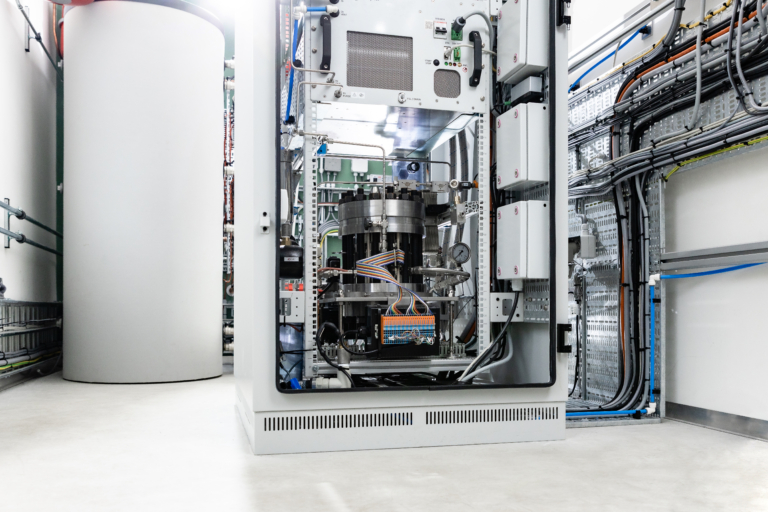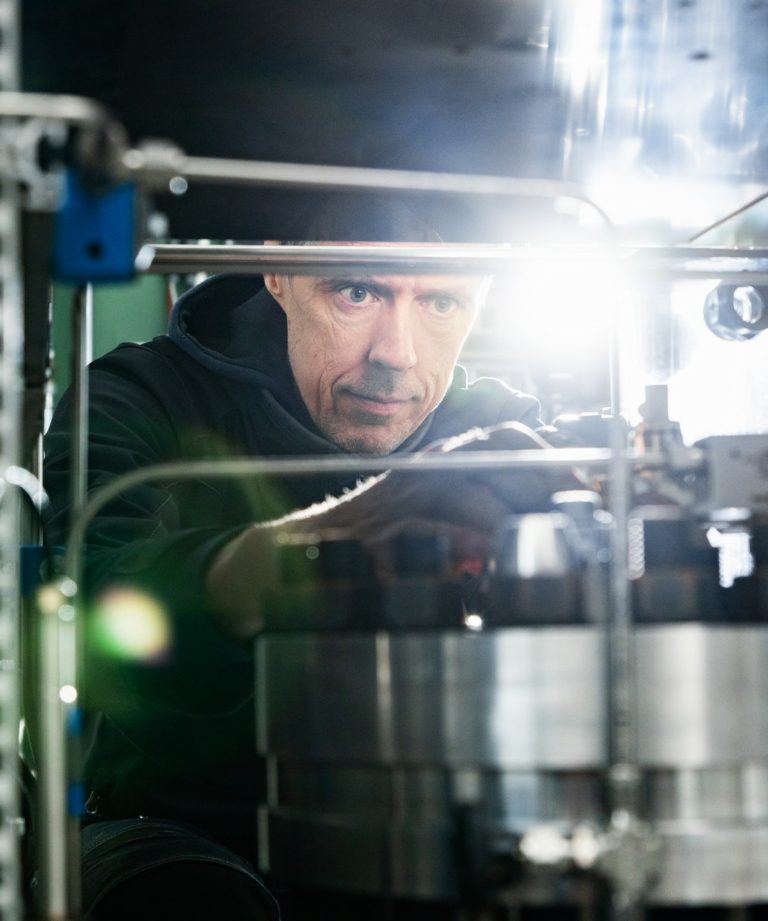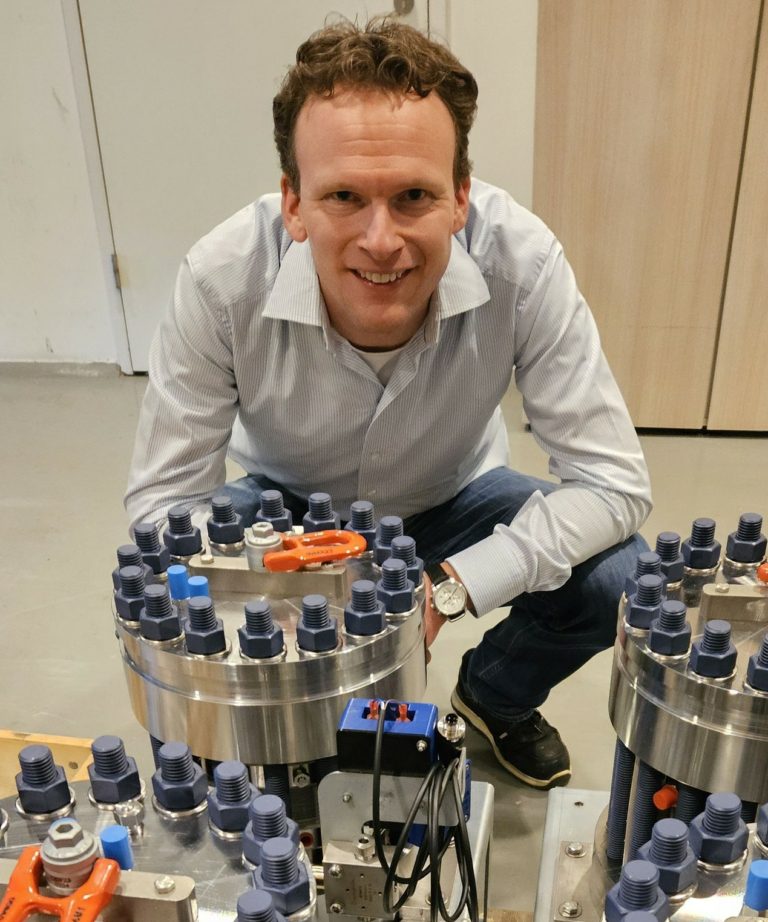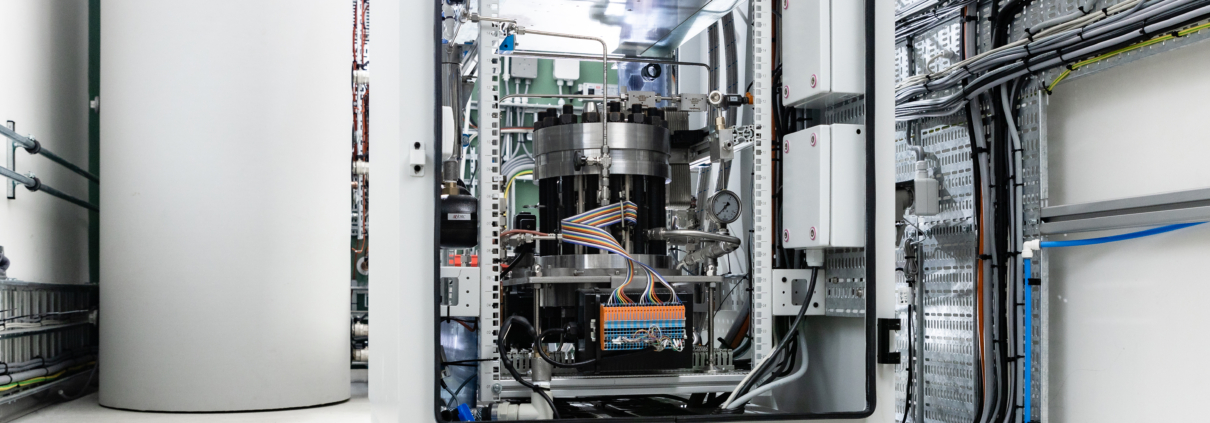Seasonal Storage System: de compressor
Het Seasonal Storage System is het flagship project van het 24/7 Energy Hub-onderzoeksprogramma. Met het systeem produceren we dagelijks waterstof op ons fieldlab. Dat is mede mogelijk gemaakt door de compressor, een belangrijk component geleverd door HyET Hydrogen. Met een vruchtbare samenwerking tot gevolg. Joel Bosrup (Wintersol) en Leonard Raymakers (HyET Hydrogen) blikken terug.
Joel startte met zijn bedrijf Wintersol in 2019, met het idee om een systeem voor lokale opslag van hernieuwbare energie te bouwen. Zo werkt hij aan de verduurzaming van de gebouwde omgeving. Hij kwam in contact met The Green Village via HyET Hydrogen, de producent van de compressor. Zij richten zich met een nog niet eerder gebruikte technologie op efficiënte waterstofcompressie. De technologie werkt ook voor het zuiveren van waterstof. HyET Hydrogen ziet potentieel in kleinere energieopslagsystemen, waarin hun compressor een belangrijke rol kan spelen.

Seasonal Storage System
Als de motor van een auto
De compressor zorgt ervoor dat dezelfde hoeveelheid waterstof in minder ruimte kan worden opgeslagen. Het comprimeert, of verkleint, de waterstof zodat het in de cilinders past. Joel: “Het is een sleutelcomponent. De cilinders nemen in deze vorm al behoorlijk wat ruimte in beslag. Zonder de compressor is er tien keer zoveel volume nodig. Dan is het minder haalbaar om deze hoeveelheid waterstof op te slaan.”
De compressor werd in zijn geheel geleverd. Aan Joel de schone taak om de machine te integreren in het Seasonal Storage System. Dat was verre van plug-and-play: “Je kunt de compressor vergelijken met de motor van een auto,” legt Joel uit. “De auto moesten we eromheen nog bouwen. De compressorstack voert daadwerkelijk de compressie uit: lagedruk waterstof wordt aan de ene kant toegepast. Hogedruk waterstof komt er aan de andere kant uit. Maar dan ben je er nog niet. Er zijn koelelementen nodig voor wanneer de stack warmte genereert. Ik heb allerlei bevochtiging- en veiligheidsmechanismen geïmplementeerd aan zowel de waterstofinlaat- als de uitlaatzijde. Dat is bescherming tegen overdruk. Een nauwe samenwerking met HyET Hydrogen was essentieel om het werkend te krijgen.”

De compressor
Geleerde lessen
Dit is de eerste keer dat een kant-en-klare HyET-compressor is geïntegreerd in een specifieke omgeving. Een uniek project dus, legt Leonard uit: “HyET Hydrogen leert veel van de knelpunten waar Joel tegenaan loopt. Vooral aan operationele zijde. Er zijn vragen zoals: hoe kan dit systeem, dat wordt gevoed met zonnepanelen, eerst een batterij opladen en vervolgens de elektrolyse starten? Joel heeft goed werk verricht door dat te modelleren, het systeem goed te ontwerpen en dimensies correct toe te passen. Veldgegevens over een daadwerkelijk systeem zijn belangrijk voor ons. Zo kunnen we het product blijven verbeteren.”
“Alles was nieuw en deden we voor het eerst”, voegt Joel toe. “We hebben veel lange sessies gehad voor veiligheidsevaluaties. Dat lijkt saai, maar achteraf ben je echt blij dat je het hebt gedaan. Nu kunnen we met vertrouwen zeggen dat het systeem veilig is. En het vertrouwen dat HyET in mij heeft gesteld, is hartverwarmend. Ze hebben veel uren geïnvesteerd in dit project. Daar ben ik ze heel dankbaar voor.”


Joel Bosrup & Leonard Raymakers
Testen op The Green Village
HyET Hydrogen kan niet wachten op de resultaten van de tests bij The Green Village: “We zien een toenemende vraag naar onze compressor in deze specifieke toepassing. Dat hadden we een aantal jaar geleden echt niet voorzien. De informatie en gegevens die The Green Village biedt, zijn zeer waardevol voor toekomstige projecten.”
En dat is niet het enige voordeel van The Green Village, volgens Leonard. “The Green Village is een zeer bekende testlocatie in Nederland, zeker ook als het over waterstof gaat. Het feit dat de HyET-compressor daar deel van uitmaakt, helpt ons om te laten zien dat de technologie werkt.”
Lees meer over 24/7 Energy Hub.
Foto’s: Jurriaan Huting
————————————————————————————————————————————————————————————————————————————–
De techniek: hoe werkt de compressor van HyET?
Voor de compressor wordt een proton-geleidende membraan gebruikt. Het is een zeer dun vel polymeer met aan beide zijden een katalysator. Wanneer waterstof aan het membraan wordt aangeboden, gaat het van de ene kant van het membraan naar de andere kant, gewoon door een elektrische stroom. Het kan niet teruggaan door het membraan. Het membraan zelf beweegt niet, dus er is geen wrijving. Uiteindelijk krijg je steeds meer waterstof aan de andere kant van het membraan. Wanneer je dat volume sluit door een buffertank toe te voegen, wordt de buffertank langzaam voller. De druk neemt toe en kan oplopen tot 500 bar. In het 24/7-project gaan we tot 300 bar. Het ontbreken van bewegende delen maakt deze compressor zeer eenvoudig, compact en stil.







